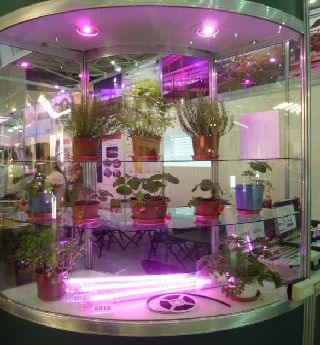The advanced technology of LED chip and package manufacturers as well as the declined market price has allowed LED lighting applications to be more diverse, and LED based-plant factories have also become the target market of global first-tier LED manufacturers. In fact, the idea of growing plants with electric lights has already been proposed in 1950 and implemented in 1970 (using traditional lighting products). Their goal was to grow high quality crops throughout the year and avoid damage caused by natural conditions and the excessive use of pesticides.

LED lighting has become crucial to plant factories because compared with traditional halogen and fluorescent lights, LED lights are not only more environmentally friendly but also more effective. LED lighting is adjustable and requires less electricity; different wavelengths of LED lighting could be matched with various types of plants, and an appropriate amount of lighting could be supplemented according to the sunshine duration. By directing certain wavelengths of LED lighting, different plants may receive sufficient lighting (though still weaker than sunlight). Sunlight is unavailable during night time, thus the supplement of LED lighting may assist in shortening the growing period of plants.
LED light source and turnkey projects
LED manufacturers are currently supplying sufficient high-quality products to plant factories for a reasonable price. They sell products mostly in two different methods; one is to supply only LED light source to plant factories, and the other is to supply turnkey projects. LEDinside indicated that instructions for the use of each light source on different plants may be very helpful to the users. In addition, manufacturers would design a variety of LED lighting and environmental control systems based on the needs of customers. In this case, they are not only selling LED lighting products, but also increasing their technology as well as the product’s value.
Basic greenhouse vs. full environmental control
LEDinside indicated that plant factories could be divided into two types: basic greenhouse and full environmental control. The initial construction cost is the major concern of manufacturers. According to industry experts, in an environment with good climate and soil, like Taiwan's and south-east part of Mainland China's agricultural conditions, a basic greenhouse would be enough to enhance the capacity of plant factories; a full environmental control would cost much more than a basic greenhouse, and such high cost may bring additional pressure to the manufacturers.
A plant factory with full environmental control covers light, temperature, humidity, nutrients, water, carbon dioxide, and other environmental factors. Under full environmental control, a tightly regulated and continuous production could take place in the plant factory. Due to the higher construction cost, this type of plant factory is more suitable for growing high value crops or high-priced ornamental plants.
White light LED vs. red/blue light LED
There are two major light sources that are applied in plant factories; one is the white light that was processed by fluorescent powder, the other is the mix of red, blue and UV LED that are able to supplement certain wavelengths to different plants. During photosynthesis, plants mostly absorb visible and ultraviolet light; in other words, plants only need red/blue light in order to perform photosynthesis (the best performance can be achieved with 650-655nm red wavelength and 450-470nm blue wavelength). Therefore, the mixed LED light source is more suitable for growing plants than the white light source.
LEDinside discovered that instead of applying the more suitable red/blue LED light source, most plant factories apply the white LED light source. Market experts indicated that manufacturers chose to apply the white LED light source (which is also more similar to sunlight) because white light can be converted according to different conditions, and under white light, manufacturers could observe the plants more easily.
Relative Articles
Author: LEDinside pinchun.chou





 CN
TW
EN
CN
TW
EN






